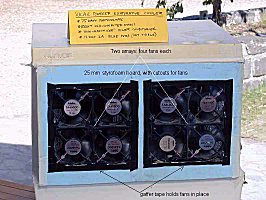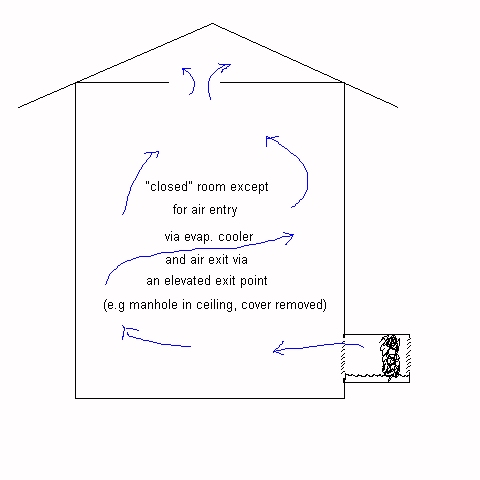
The Competitive Edge......
........or how to keep your cool in a deregulated energy market.by Michael Gunter

by Michael Gunter
The Problem: "Crunch Time" 1st January 2001 is rapidly approaching. How should you respond when electricity retailers are selling heat pumps to fill their coffers in the winter-time, when economic uncertainty is impacting on infrastructure investment decisions, and when all the players in the deregulated energy markets are chasing market share and emissions growth, or just being ultra-conservative screen jockeys who don't know a megawatt from a megawatt-hour? Welcome to the world of deregulated energy markets!
You could get advice from a market analyst, and try to learn how to negotiate with a variety of electricity retailers in order to strike a deal for the best price per kilowatt-hour. You could be seduced by slick marketing to buy a heat pump air conditioner in the hope that affordable electricity prices (and a lack of power restrictions or blackouts) will make it a useable asset.
Or you might decide to walk away from the whole tawdry mess of electricity industry privatisation, and strike a blow for energy independence, by implementing a series of economically efficient strategies. These might include: buying low energy light globes; unplugging all appliances at night; shading summer sun from all exposed windows to the east, north and west of your premises; installing a solar water heater; and even making a solar powered evaporative cooler as a do-it-yourself project! (see below).
This is especially the case if you are a home owner wondering how best to invest in renewable energy to create a sustainable future for your kids. Well-off people with some spare cash to splash are particulary the ones who should consider leveraging the competitive energy market: they tend to burn more fossil fuels, one way or another, than the poorer sections of Australian society, and by exercising their commercial clout in the electricity market en masse, can potentially help to keep electricity prices lower for everybody next summer. This is because energy conservation on a wide scale can help lower the cost of wholesale electricity generation, this in turn helps ensure that electricity prices for all consumers will be lower than would otherwise be the case. It is also getting to the stage where somebody is going to have to take responsibility for preventing power blackouts during heatwaves, and, on recent form, it seems that neither state governments, privatised electricity industry participants nor trade unions can necessarily be relied upon for common-sense action in the public interest:
Summertime Blues. Air conditioning load, in the form of reverse cycle heat pumps has been creeping into modern homes and offices at an alarming rate. In our free market there seem to be no controls on the amount of installed capacity. The market design almost demands that shortages must occur, triggering massive electricity price rises, before the "market signal" is created to start the building of more electric power stations. This is the crazy implementation of market reform we are stuck with, at a time when Australia, the notorious OECD greenhouse emissions basket-case, is supposed to be reducing greenhouse emissions! The Electricity Supply Association of Australia is on the public record in castigating consumers for our profligate wastage of electricity, so the industry cannot possibly complain if we take the initiative in forcing real reductions in electricity consumption and greenhouse gas emissions.
The solution: Apart from solar water heating and energy conservation measures mentioned above, the big thing every non-tropical Australian can do is buy, beg, borrow or steal an evaporative cooler, so that your reverse cycle heat pump can be reserved for what it was supposedly purchased for: namely winter heating. People, yes even rich people, should be prepared to tolerate the lesser comfort of evaporative cooling, safe in the knowledge that they are doing something really effective to mitigate greenhouse gas emissions, prevent global warming, suppress summertime electricity prices, and even improve Australia's balance of payments by not having to import all the parts for the construction of unnecessary power stations. This is yet another classic case where suppressing the nation's GDP has hugely positive effects on our quality of life and our "sustainability index".
Free Air Conditioning: My prototype solar powered evaporative cooler is great in the situation where there is a failure of the electricity market during a heatwave (i.e. a power blackout or power restricitions). With a BP Solar 75 watt panel, a "Rule" 12 volt bilge pump and 8, 12 or 20 second-hand computer fans, it is possible to make your own cooling sytem that will keep a well shaded room reasonably comfortable through even severe dry summer heatwaves: Figure 1 indicates that the computer fans are connected in a tight-fitting array across the front or back of any old evaporative cooler. The standard evaporative cooler can retain its AC motor and pump, or can be gutted, as all we need from it is the air tight box, the water tray and the aspen (wood shavings) evaporative pad or "filter". An integral part of this arrangement is a Mini Maximiser current pulsing FET switch which allows excellent start-up each morning, and even some functionality under hazy or slightly overcast skies. The computer fans can be substituted with a single large 12 or 24 volt DC fan such as the Davies-Craig automotive cooling fan, say a 25 cm or 30 cm diameter model. The Voltscommissar home page contains links to additional description of the unit, and some photos of the prototype in action at the CERES site on a very hot day last summer.
Figure 2 is the schematic electrical diagram. My BP Solar 75 watt panel has a 6 volt tap in its junction box, and this is ideal for running the bilge pump under full-sun conditions, as it will greatly extend the life of the pump at this lower voltage (7 to 8 volts in practice), AND allow more power to the air fans. The positive supply rail from the PV panel to the pump, via the Mini Maximiser, must be the NON-SWITCHED supply to the pump. The simplest way to understand all this is to study Figure 2 showing a POSITIVE EARTH supply rail at the bottom: this is "zero volts" and the Mini Maximiser gets a "minus twelve volt" supply from the PV, while the bilge pump has the option of being supplied via the MiniMaximiser, or direct from the "minus six volt" rail from the PV.
Optimising cooling performance
Most suppliers sell small room coolers on a pedestal or trolley. You are supposed to place it inside the room near an open window. This would be fine if it was easy, or even possible at all, to make a tight seal between the rear inlet of the cooler, and the open window.The lowest room temperature can be obtained only by minimising the flow of hot air into the room or space to be cooled. It is also extremely important of course to provide external shading with trees, blinds (awnings), shutters, or even bed sheets (!) to prevent any direct sunlight entering the room.
The best way to prevent hot air entering the room is to install your cooler outdoors, and blow the air in through a casement (slide-up-and-down) window, ideally at floor level. Suitable baffles to create a close fit between the front of the cooler and the window frame can be constructed from scrap styrofoam, cardboard and duct tape, or even cloth bolsters packed with spun acrylic fibre or foam plastic. Just about any lightweight object that can plug the gaps will greatly reduce the intrusion of hot "untreated" air into the room.
Seal up the rest of the house, close all the doors (oops, you have an open-plan house? bad luck...)
